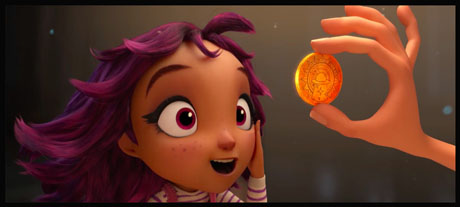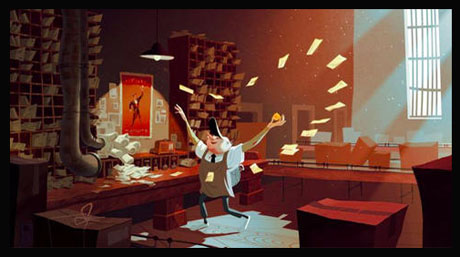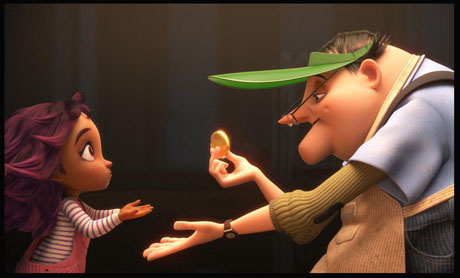
A girl, a postman, a coin and some magic. They’re the components of To: Gerard, a new DreamWorks Animation short from writer/director Taylor Meacham. You’ll be able to watch it soon. In the meantime, the short recently picked-up a big award at this year’s virtual Annecy Film Festival.
Jackson Murphy: Congrats on the Annecy honor. It had to go to a virtual festival this year because of everything going on. But you were still able to have this short compete and be shown. You won the Junior Jury Award for Short Film. How does that feel?
Taylor Meacham: It feels great. So many of us have worked so hard on this film. To finally have it out there and to have it recognized on top of that. It’s a very personal film so that seems to be a nice reflection of how everyone’s been feeling from the film, too and responding to it.

JM: I watched it the other night. It’s lovely and so cool in its visual style. First of all, where did the inspiration come from? Was it a love of magic, the postal service, or a little bit of both.
TM: (laughs) A little bit of both, actually. The core of the story comes from the inspiration from my father. I feel so, so lucky to have had parents that, no matter what I wanted to do in life, they would be very supportive of it. The financial situation that my dad’s been in… he’s in his late 60s now and he should be at a place to retire. Him still, no matter what, even if he’s in a bad financial situation, wanting to do whatever he could to support his kids. That was something so inspirational. And that kind of kicked off the basis of the theme about how the greatest magic in life is being able to inspire somebody else to follow their dreams even if you haven’t had the opportunity yourself.
I’ve always loved the idea that Gerard would work in a post office. I feel like (probably with the exception of “Klaus” more recently) when I came-up with the idea, that job and area was seldom explored in animation. I always felt like there was some more room there for invention in terms of set-design and how it informed our character. I really wanted Gerard’s profession to support how he felt isolated and ignored at the beginning of the film.

Taylor Meacham
On the magic side of it, I went to Magic Camp when I was a kid… on the east coast. I had such a great time. I met such amazing people. A lot of those people I went to camp with are professional magicians now. Although I didn’t stick with magic, that was my first little seed of inspiration for magic to go off and tell stories. A lot of magic that I love always had a great story behind it. That inspired my passion for telling stories.
JM: Did you ask some of your friends who are magicians or any other magicians for some advice or for some angles of incorporating the magic scenes in “To: Gerard”?
TM: Yeah, sort of. We did a couple things for it. It was really important for me, especially going into the animation process and when talking with animators, that in animation… the limits are endless across the board. So when you incorporate magic into animation, you can still kind of do whatever you want. And it was really important to me because the magic I love is a very real thing. Real people can do it. Obviously we have [David] Copperfield making the Statue of Liberty disappear and all these amazing feats. But I didn’t want to take too many liberties with that and with the magic Gerard performs to himself. So I wanted to keep it contained to a coin.
I do have friends who are magicians, and on the side I would talk to them about, “You know it’d be really interesting to have an animated film that has magic in it.” Our character is doing real magic. He is doing magic in the way that I could go see a show and do magic. It’s very rare that you go to a show and that person makes the Statue of Liberty disappear. Something that’s small or close-up magic or stage magic as we see later… it was important that we honored what’s involved in being a magician.
When we got to animation… we were able to take practically our whole animation team to the Magic Castle as a “research trip”. And for a lot of our animators, they hadn’t really seen that caliber of magic anymore. We had an amazing time. It was so great to see people who probably weren’t even that interested in magic being like, “Oh my God! That was the most amazing thing I had ever seen!” And I really feel like that helped their excitement and passion for their project and who Gerard was – seeing all those magicians with such a love for this art.

JM: You’re so right about that. I’m into that. I watch “Penn & Teller: Fool Us”. It’s a great show. And there’s such an intimacy with magic, especially with close-up magic. And you feel that intimacy in watching To: Gerard – his relationship with Jules. The story adds an emotional layer upon an emotional layer and it keeps going and going. Was that always the intention to break it up into three or four acts within this seven and a half minute short?
TM: Absolutely. With a short film, you have very limited time to explore a lot of things, and you can get very easily caught up in trying to be way more high concept than you really have time for. I tried to keep it very simple, and hopefully it’s disguised a little bit through what actually happens in the short. Because I wanted to put so much into it, I wanted to make sure we weren’t waiting too long for anything. And we still had an element of surprise in it. Personally, with the stories I love and the stories I love to tell, I believe that above all else, the audience or anyone who’s watching a story, they remember emotions before anything else.
You can have a million jokes in a movie or a short film but what people really take away is how that story made them feel. First it’s how I’m feeling about it and then now that I’m opening myself up, what does that make me think about? And then, did it bring me joy? Which is where the laughter comes in. So I really wanted people to walk away with a distinct feeling.
JM: You also worked on Trolls for DreamWorks as a production coordinator. People remember “Can’t Stop the Feeling” and the colorful animation. But “True Colors” – that performance – is still what stands out in my mind from watching the first Trolls. So I see where you’re coming from with that. What important pieces of mail did you receive while making To: Gerard?
TM: I don’t get a lot of mail. I get bills and stuff like that. But every now and then I’ll get a letter from my parents. And I have a letter from my Dad. It was a Christmas card I got from him: “My son Taylor. My chest swells with pride. My heart fills with joy with the thought of you.” And that’s all the letter said. That was from 2017, and this was in the middle of production. And it’s stuff like that. I keep cards and letters in a shoe box. That particular one I ended-up hanging up. It’s nice to get some stuff like that. There’s something that’s really personal about a written letter. You can keep it, hang it up and remember it. It feels really special. And I wanna do that for somebody else.
JM: Yes and keep that going on. That’s one of the big themes of “To: Gerard”. And something tangible, like this coin. Did you know it was always gonna be a coin?
TM: Absolutely. I love coin magic. In magic, it’s almost a cliche but it’s special… when I was a kid growing up, if you run into a magician at a restaurant or you go to a show, usually there’s a point where they invite you up on stage. And they let you participate in the illusion they’re doing. At the end you usually have something to take home. More often than not, even if it’s a little piece of magic they’re showing you, sometimes you’re walking away with a coin. I have magic memorabilia that I’ve kept over the years. I knew that it needed to be a coin because that’s not uncommon. I felt like that was a very relatable thing.

JM: What will also impress people who are into magic is that you keep the tone and the visual look and even with the score by Layla Manoui classy and old-fashioned and kind of nostalgic magic. Even with Piotr Michael’s voice work as Vivonti, who was Gerard’s inspiration. He has this classic, older gentleman magician voice. Was there ever any temptation to make it modern magic influences or did you know, “We have to keep it classic and classy”?
TM: Yeah. In the story there’s no real exact date. When you’re developing a project, usually people wanna know, “When does this take place?” And I really fought that question – not because I didn’t know, but more so because there are so many elements that I wanted to have this nostalgic feeling to. And I didn’t want to necessarily put it in the ’80s or the ’70s or the early ’90s. There are different design aspects to it that are going from different decades.
When we got Piotr as a voice actor, my producer and I were not expecting that voice to come out of him. I had done a temporary voice reading before we had found the right actor for it. And I was doing this fast-talking, ’50s, newspaper journalist voice. I was doing that for fun. My instinct, because of that, was that I want something that has more of an age to it. We had a handful of amazing, awesome actors that came in. And then we got Piotr – he came in and delivered this perfect voice. There was no debate. That was our Vivonti. He has such a wide range of voices he can do. I really enjoyed working with him.
JM: Taylor, you are now an Annecy winner. To: Gerard is coming soon. It’s rated G. It’s appropriate for everybody. We’ll see where it plays for families to watch this. Are you working on other shorts at DreamWorks based off of the success of this?
TM: I don’t wanna give too much away, but I’m excited on what potentially could come next. I don’t know if shorts are necessarily in the cards. But it’s been really wonderful to get the story out there and to hear the great response for it. So we’ll have to see! I’m gonna give you the most general response possible. (laughs) But I’ll tell you I love stories that have to do with hope. And I think that whenever we get back to theaters, or even when we’re home watching movies or TV shows, the movies that matter to me that I love to this day are movies that really make me feel something hopeful. And they either give me hope that there’s good in all people. Those are the movies I wanna tell. And maybe the next thing I do is something around that.
JM: Yeah. I was gonna say, that’s the clue you’re giving us. It’s a film with hope. Or a short with hope. Or an animated holiday special with hope.
TM: (laughs)
- INTERVIEW: “Puffin Rock And The New Friends” And 25 Years Of Cartoon Saloon - April 10, 2024
- INTERVIEW: “Chicken For Linda!” Directors On Annecy Winning Feature - April 9, 2024
- INTERVIEW: Time To Explore New “DORA” Series - April 8, 2024


 June 29th, 2020
June 29th, 2020  Jackson Murphy
Jackson Murphy  Posted in
Posted in  Tags:
Tags: 






